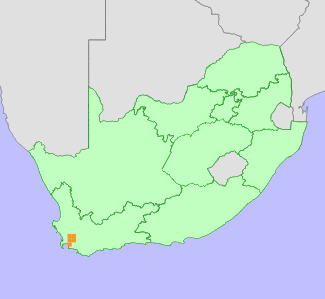|
Scientific Name | Leucospermum lineare R.Br. |
Higher Classification | Dicotyledons |
Family | PROTEACEAE |
Common Names | Luisiesbos (a), Needle-leaf Pincushion (e) |
National Status |
Status and Criteria | Near Threatened B1ab(ii,iii,iv,v)+2ab(ii,iii,iv,v) |
Assessment Date | 2020/06/19 |
Assessor(s) | A.G. Rebelo, H. Mtshali & L. von Staden |
Justification | Leucospermum lineare has a limited distribution range, with an extent of occurrence of 958 (EOO) km², and an area of occupancy (AOO) of 324-332 km². It is declining across its range due to wild flower harvesting, ongoing habitat loss and degradation, but is still common, occurring at more than 10 locations. Therefore it nearly meets the thresholds for Vulnerable under criterion B and is listed as Near Threatened. |
Distribution |
Endemism | South African endemic |
Provincial distribution | Western Cape |
Range | This species is endemic to Western Cape Province of South Africa, where it occurs from Bain's Kloof to the Hottentots Holland and Villiersdorp mountains. |
Habitat and Ecology |
Major system | Terrestrial |
Major habitats | Cape Winelands Shale Fynbos, Boland Granite Fynbos, Western Coastal Shale Band Vegetation |
Description | It occurs in granite-derived clay soils, 200-1000 m. It is a short-lived species with a generation length of 15-20 years. Mature individuals are killed by fires, and only seeds survive. Seeds are released after ripening, and dispersed by ants to their underground nests, where they are protected from predation and fire. It is pollinated by birds. |
Threats |
| About 31% of this species' habitat is already irreversibly modified, predominantly due to historical habitat loss to damming, agricultural expansion and pine plantations. There is slow, ongoing habitat loss, but since the majority of this species' habitat is now formally protected, habitat loss over the past 24 years has dropped to 3%.
Alien invasive plants, particularly pines, are spreading uncontrolled in the Bains Kloof, Du Toit's Kloof and Hawequas Mountains. At present invasions are largely restricted to lower slopes, but once they reach the summit ridges and peaks where this taxon occurs, it is likely to lead to a rapid increase in risk of extinction. This species is also threatened by harvesting for the cut flower industry and collection for horticulture. The population is potentially threatened by too frequent fires. As a reseeder, it is likely to decline and disappear in areas that are repeatedly burnt before plants reach reproductive maturity. |
Population |
It is known from 81 subpopulations in a 50 km range. Subpopulations are isolated, but often dense. The Paarl Mountain subpopulation is extinct. It appears that many lowland sites may have been lost. It is still very common in Jonkershoek, Du Toit's Kloof, Wellington-Bain's Kloof, Drakenstein and Franschhoek, in natural veld abutting farmland. Ongoing population decline is inferred from ongoing habitat loss and degradation.
|
Population trend | Decreasing |
Conservation |
| The Assegaaiboskloof subpopulation is mooted for transfer to the Hottentot’s Holland Nature Reserve at a future date. It is presently conserved at Haweqwa, Mont Rochelle, Hottentot’s Holland and Theewaters nature reserves. |
Notes |
| There are two forms of this species. The common form sprawls and has a yellow perianth and style. The orange form found at Assegaaiboskloof is more erect with a deep orange perianth and style and slightly larger features. These differences are being evaluated to determine if the later is possibly a separate species. |
Assessment History |
Taxon assessed |
Status and Criteria |
Citation/Red List version | | Leucospermum lineare R.Br. | VU A2c | Raimondo et al. (2009) | |
Bibliography |
Goldblatt, P. and Manning, J.C. 2000. Cape Plants: A conspectus of the Cape Flora of South Africa. Strelitzia 9. National Botanical Institute, Cape Town.
Manning, J.C. and Goldblatt, P. 2012. Plants of the Greater Cape Floristic Region 1: The Core Cape Flora. Strelitzia 29. South African National Biodiversity Institute, Pretoria.
Raimondo, D., von Staden, L., Foden, W., Victor, J.E., Helme, N.A., Turner, R.C., Kamundi, D.A. and Manyama, P.A. 2009. Red List of South African Plants. Strelitzia 25. South African National Biodiversity Institute, Pretoria.
Rebelo, T. 2001. Sasol Proteas: A field guide to the proteas of southern Africa. (2nd ed.). Fernwood Press, Vlaeberg, Cape Town.
|
Citation |
| Rebelo, A.G., Mtshali, H. & von Staden, L. 2020. Leucospermum lineare R.Br. National Assessment: Red List of South African Plants version . Accessed on 2025/07/02 |
 Comment on this assessment
Comment on this assessment

